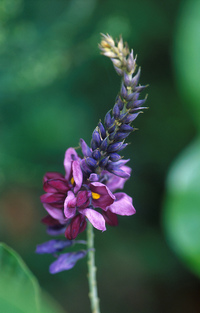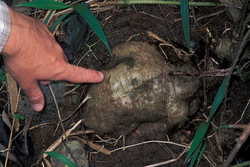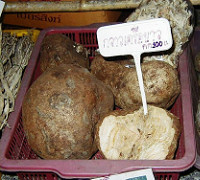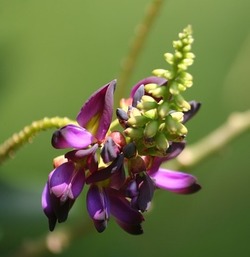Pueraria; Kudzu

This is about Pueraria for breast enhancement, and its hormonal effects on the body, including use for alleviating menstrual symptoms. Evidence of kudzu's properties is examined.
There are also suggestions of Pueraria use for effective breast enlargement.
Etymology
Pueraria is a genus of plant commonly referred to as Kudzu. Fabaceae (or Leguminosae) is the name of the family which Pueraria resides.
Here are some well known plants of Kudzu. Pueraria mirifica is a shortened term for the cultivar Pueraria candollei mirifica, which is also known as Kwao Kreu, Kwao Kreu Kao or Thai Kudzu. Japanese Arrowroot's classification is Pueraria montana lobata, which is often shortened to Pueraria lobata, where "lobata" is its variation name.
Evidence of Pueraria's properties

Pueraria mirifica has a reputation for herbal breast enlargement. This is because it has varying properties that work synergistically together.
There aren't many studies on its effects on hormone levels specifically, however, its effects on the menstrual cycle offer some clues. Pueraria often causes lighter, but longer periods. This suggests that Kudzu has estrogenic, luteinizing hormone (LH) or follicle stimulating hormone (FSH) properties that conflict with progesterone properties of this plant.
One research paper suggests that Kudzu has serotonic properties, which is associated with an increase of prolactin, and that it has estrogenic properties. Another research paper determined that Pueraria mirifica did alter menstrual cycles, but didn't appear to affect hormone levels of progesterone, LH, FSH or estrogen. This study didn't include Pueraria mirifica's effects on prolactin. It hypothesized the possibility that its estrogenic, LH or FSH properties balance out levels of progesterone. This appears to be the most likely outcome. Another possibility is that Kudzu's phytohormones or its influence on prolactin weren't tested for in serum samples.
Puerarin is a phytochemical contained in Kudzu with the ability to affect hormones, and receptors of interest. It has acted on Estrogen Receptor Beta (ERβ): agonists often simultaneously downregulate the receptor they act upon. This phytohormone also has raised growth hormone (GH), and prolactin (Prl).
Hormonal properties and their effects vary among different species of Pueraria or kudzu.
Phytohormones of interest
Pueraria contains: phyto-progestins, phyto-estrogens and lignans.
Lignans it contains are: lariciresinol, pinoresinol, syringaresinol and syringaresinol. Phytoprogestins it has are: miroestrol, deoxymiroesterol, lupenone, lupeol, beta-sitosterol, stigasterol and beta-amyrin. Saponins (likely also phytoprogestins) contained in kudzu are: Kakkasaponins, Pedunsaponins, Soyasaponins, Phaseoside and Sophoradiol monoglucuronide. Pueraria contains phytoestrogens: many are common in other plants of the legume family. Of note is puerarin.
A few phytochemicals are named from this plant, including: Puerarin, Puerariafuran and Puerol.
Anecdotal evidence

Pueraria has caused minor breast growth, but additional body hair. Kudzu has also contributed to hot-flashes. These effects imply that the effect is positive and estrogenic on ERα in the breasts (and fallopian tubes), but conditionally androgenic on ERβ in the reproductive tract. Excessive use of pueraria has stopped being effective for breast growth. This is likely because of potential desensitization of estrogen receptors, and because, like clover, estrogen's effects on the reproductive tract reduce estrogen balance in the body. It appears, pueraria can assist with balance and breast growth, but like other herbs which contain phytoestrogens, it must be avoided during proliferative phase.
Use
Pueraria for breast enhancement

Most herbs do not have the combination of phytohormones that Kudzu has, which gives Pueraria mirifica (Thai Kudzu) a reputation for bust enhancement.
Pueraria can be used in minimal amounts during mid secretory phase, but it requires herbs with antagonistic properties for consistent effects. Avoid pueraria completely during menses, proliferative phase and ovulation.
Pueraria used to be recommended for the first day menstruation with other herbs when there's no swelling/bloating, but it has been replaced.
Kudzu is best used during mid secretory phase. When used during the appropriate phase and herb combination, limit kudzu as close to under 100mg of solid form per day. Outside of luteal phase, pueraria can contribute to hot-flashes and hirsutism.
The current theory is to use Pueraria like fenugreek seed, which is when there's acne during luteal phase.
Pueraria01 was a specific herbal program based around Pueraria (kudzu) in use and in theory which is obsolete. Kudzu can likely be limited to the herb schedule when fenugreek is used, in similar amounts.
Pueraria or herbs with similar properties are in herb programs based on menstrual phases. There must be balance throughout phases, and combinations of herbs help the body acheive balance for health, breast growth and hip growth. It's important that menses is light and short. Also, preventing an excess of negative symptoms for menses helps set the balance for proliferative phase. Luteal phase uses a different combination of herbs than proliferative phase for symptoms. For a simplified herb schedule, where there's commonality of herb recommendations for symptoms such as swelling and signs of excess estrogen, use nonmenses. BCP01 is a composite page of pieces of different programs on birth control or IUD use.
Herb timing and combinations' success for breast enhancement relies on menstrual phases. Descriptions and pictures of results from herb combination use can be seen in programs. For more guidance, see guide, or hirsutism-topic.
For hormone balance

Kudzu's reputation to alleviate menstrual problems can be attributed to its hormonal effects as described in previous sections. Different species and cultivars of kudzu have different strengths of promoting or lowering menstruation, which can disrupt the menstrual cycle at other times.
Similar herbs
Shatavari (Asparagus), suma (Hebanthe), maca (Lepidium), Passionflower (Passiflora), kudzu (Pueraria) and fenugreek (Trigonella) contain both phyto-progestins and phyto-estrogens. Their properties likely vary, so they may require a different proportion or a different variation of companion herbs.
Fenugreek (Trigonella) has estrogenic compounds with effects on ERα, which Pueraria may also have. Other herbs which contain both phytoprogestins and phytoestrogens like Shatavari (asparagus) may lack this specific effect, as their estrogenic effect is limited to ERβ. These other herbs can supplement fenugreek or Pueraria.
Pueraria by itself has the same effect as the herb combination of spearmint and clover. Kudzu also has many of the same phytochemicals as clover, so it likely behaves as spearmint with clover together. Clover has a reputation for reducing fertility with some symptoms consistent with kudzu.
Fenugreek is a partial substitute and complement for pueraria, because it has properties that are more regularly positive on the reproductive tract. These herbs also require the right companion herb for improved consistency.
Precautions
While Pueraria mirifica root has been effective for natural breast enhancement, most standardized studies have shown Kudzu's hormonal effectiveness based on cancerous breast cell samples. Pueraria is likely not carcinogenic, but it seems to not discriminate between nurturing healthy and tumorous cells. Pueraria is still very useful, when used in small portions and when not used in cases prone to cancer.
Kudzu is to be avoided for those with hot-flashes, alcopecia or hirsutism.
See precautions for more details of care to be taken with herb use. Proper nutrition is a consideration for health. Also, check for the latest blog updates about herb and hormone safety.
It is very important that menses be light and not prolonged.
If you have hirsutism, PCOS, hot-flashes, other signs of hormone imbalances, see estrogen-imbalance, and hirsutism program journals at hirusitism-topic before trying herbs.
Herb concentrates can be tens of times more potent by weight than herbs in solid form. This can easily lead to hormone imbalances. For this reason, concentrate extracts are not recommended for extended or excessive internal use, especially during fertility years. Concentrates shouldn't be used to overcome plateaus. Another issue with herbal extracts, is that they may not have the full range of properties of the herb. Essential oils are not recommended for breast enhancement. If opting to use herbal extracts, use food grade extracts, with no more than 1 drop at a time diluted in water.
More


For the latest herb programs and how to get started, see: guide. Pictures of breast enhancement can be seen in the program journals of Anon02, Anon08, Anon09, Bubblemelon and Jellie.
For resources on hips and butt enhancement, see: /appendix/hips-butt-enhancement and /appendix/kettlebell.
breast-endocrinology.pdf describes the science of breast development and endocrinology. It also describes symptoms related to hormone imbalances. Biology and hormone imbalances are excerpts from this ebook. breast-endocrinology.pdf uses a Creative Commons (CC BY-ND 4.0) license.
Breast.is blog
References:
- Botanical modulation of menopausal symptoms: mechanisms of action?. https://www.ncbi.nlm.nih.gov/pmc/articles/PMC3800090/.
- Estrogenic effects of Pueraria mirifica on the menstrual cycle and hormone-related ovarian functions in cyclic female cynomolgus monkeys. https://www.ncbi.nlm.nih.gov/pubmed/14745118.
- Evaluation of in vivo estrogenic potency of natural estrogen-active chemical, puerarin, on pituitary function in gonadectomized female rats. https://www.ncbi.nlm.nih.gov/pubmed/27615593.
- Anti-Endometriotic Effects of Pueraria Flower Extract in Human Endometriotic Cells and Mice. https://www.ncbi.nlm.nih.gov/pubmed/28264481.
- Pueraria mirifica Exerts Estrogenic Effects in the Mammary Gland and Uterus and Promotes Mammary Carcinogenesis in Donryu Rats. https://www.ncbi.nlm.nih.gov/pubmed/27827907.
- A comprehensive review on Pueraria: Insights on its chemistry and medicinal value. https://pubmed.ncbi.nlm.nih.gov/32942158/.
Etymology & Definitions:
- Sorting Pueraria names. http://www.plantnames.unimelb.edu.au/Sorting/Pueraria.html.
- Classification for Kingdom Plantae Down to Genus Pueraria DC. http://plants.usda.gov/java/ClassificationServlet?source=display&classid=PUERA.
- U.S. National Plant Germplasm System: Pueraria candollei var. mirifica. https://npgsweb.ars-grin.gov/gringlobal/taxonomydetail.aspx?id=317850.
- U.S. National Plant Germplasm System: Pueraria montana var. lobata. https://npgsweb.ars-grin.gov/gringlobal/taxonomydetail.aspx?id=314966.
- International Plant Names Index: Leguminosae Pueraria candollei. http://www.ipni.org/ipni/idPlantNameSearch.do?id=967645-1&show_history=false&output_format=normal.
Resources:
- Pueraria mirifica alleviates cortical bone loss in naturally menopausal monkeys.. https://www.ncbi.nlm.nih.gov/pubmed/27601445.
